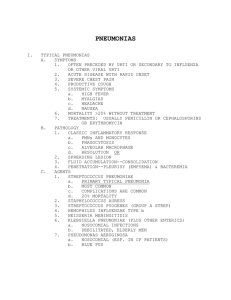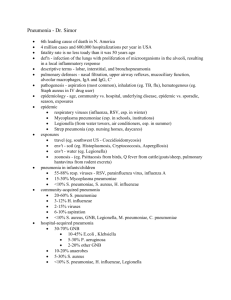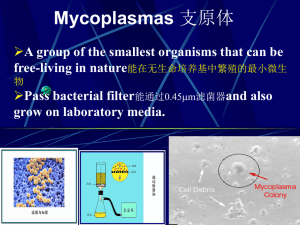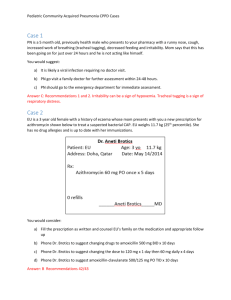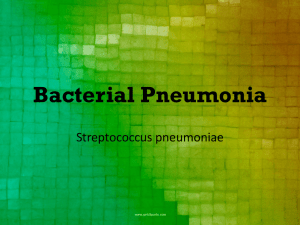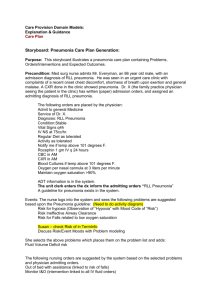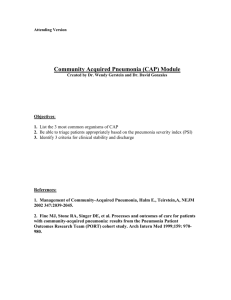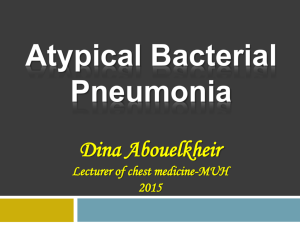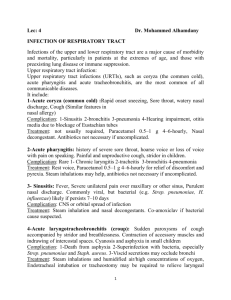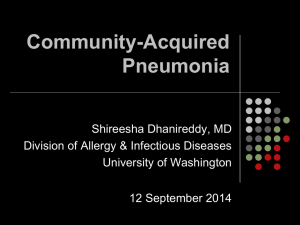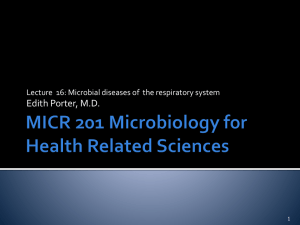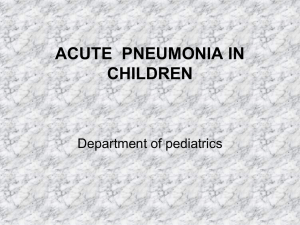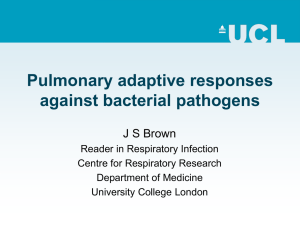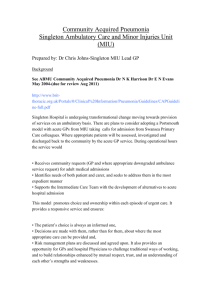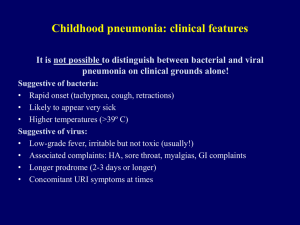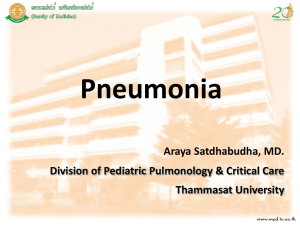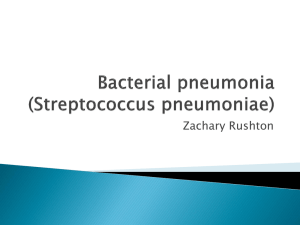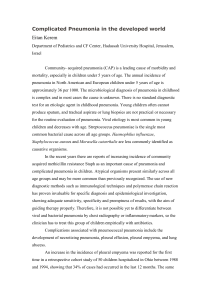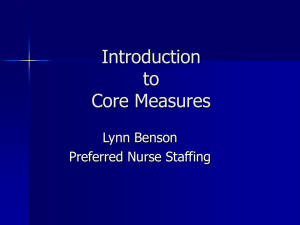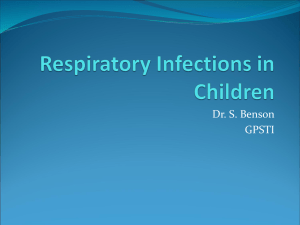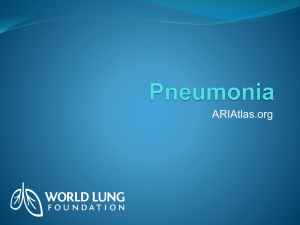Community acquired pneumonia
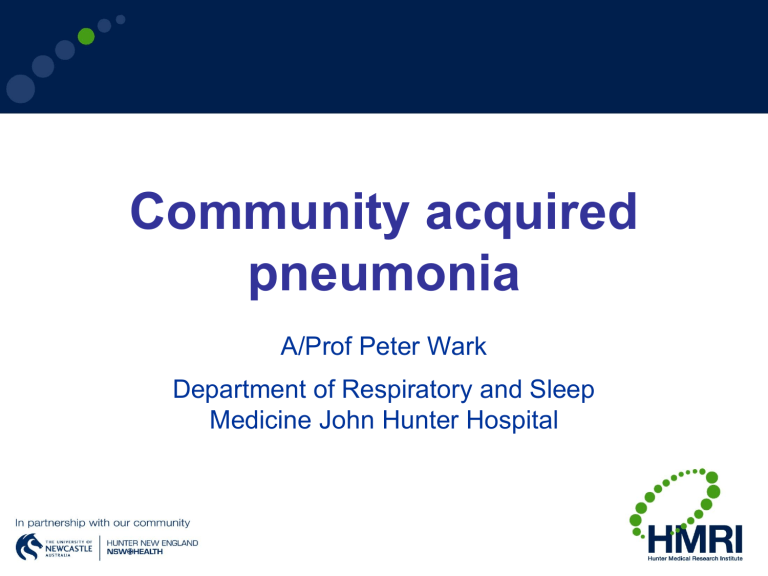
Community acquired pneumonia
A/Prof Peter Wark
Department of Respiratory and Sleep
Medicine John Hunter Hospital
• Ms AN, 37 year old
• Previously well
• 3 day history
– Sore throat
– Dry cough
• Today
– Left sided sharp chest pain
– Felt hot and unwell, rigors
Differential diagnosis
• Pneumonia
• Bronchitis
• Asthma
• Pulmonary embolus
Epidemiology
• In US pneumonia
– 6 th leading cause of death
– Leading cause of death from an infectious disease
• Mortality
– 1-5%
– Up to 40%
Identifying a pathogen
Identifying a pathogen
• In clinical practice an organism is found in only 50%
• No single test is available that can identify all organisms
• History, clinical findings and X-ray changes are not diagnostic of a particular organism
• ? Mixed infection, especially viral and bacterial
CAP, no history of significant chronic disease
• 20-60%, Strep Pneumoniae
• 3-37%, Mycoplasma Pneumoniae and
Chlamydia Pneumoniae
• 10% cases
– Viral (exceptions influenza, adenovirus)
– Staph Aureus (MSSA and MRSA)
– Gram neg organisms
– Legionella pneumophilia (3-10%)
CAP and co-morbid diseases
• Risk is increased
– Nursing home resident
– Cardiorespiratory disease (COPD, CCF)
– Immunosuppression
– Alcoholism
– Recent antibiotic use
– Age > 65 years
• Cause
– more gram negative organisms or resistant pathogens
– Viral (CMV, VSZ, respiratory viruses
– PCP
– Fungal
Severe CAP
• 20-50%, Strep Pneumoniae
• 10-30% E.Coli, K Pneumoniae, Enterobacter
• 3-10% Legionella pneumophilia (adm ICU)
• Staph Aureus
– MSSA
– MRSA
• Viral
• Pseudomonas Aerugniosa ?
Viral pneumonia
• PCR improves detection
• Some series, accounts for up to 24%
• Not predicted by CXR or CRP
• Pathogens
– Influenza
– SARS
– RSV
– Rhinovirus (co-pathogen 35% severe CAP)
– Adenovirus
How to identify the pathogen?
Sputum
• Sensitivity 10-54%
• “good sample” and cultured quickly
• Gram stain positive (esp Pneumococcus)
• Culture best with heavy growth and correlation with gram stain
• Special culture medium for Legionella, sensitivity 10-
80% (better with BAL), specificity 80%
• High false positive, especially Staph Aureus & GNB
Blood cultures
• Sensitivity 7-16%, specificity 90% (depends on organism)
• Strep Pneumoniae,
– accounts for 2/3 positive blood cultures
– Pneumococcal bacteraemia, 1%, mortality 19% vs
4% hospitalised with pneumococcal pneumonia
Urinary antigens
• Detection of Strep Pneumoniae & Legionella
• Advantages
– Easily available
– Valid after antibiotics initiated
• Pneumococcus
– Sensitivity 82%, specificity 97% (bacteraemic)
• Legionella
– Sensitivity 70-80%, specificity 97%
– Only L. Pneumophilia
Severity scoring
• CURB-65
– Confusion (1 point)
– Urea >7mmols (1)
– Respiratory rate >30 (1)
– BP, systolic <90 or diastolic < 60 (1)
– Age >65yrs
Score
0-1
2-3
3-5
Implication
Risk death <3%, OP
Risk death 9% hospitalise
Mortality 15-40% consider
ICU
PSI in adults
Sex
M (0 points)
F (-10 points)
Demographic factors
Age (1 point for each year)
Nursing home resident (10 points)
Comorbid illnesses
Neoplastic disease (30 points)
Liver disease (20 points)
Congestive heart failure (10 points)
Cerebrovascular disease (10 points)
Renal disease (10 points)
Physical examination findings
Altered mental status (20 points)
Respiratory rate >= 30/minute (20 points)
Systolic blood pressure < 90 mmHg (20 points)
Temperature < 35 degrees C or >= 40 degrees C (15 points)
Pulse >= 125/minute (10 points)
PSI in adults
Laboratory and radiographic findings
Arterial pH < 7.35 (30 points)
Blood urea nitrogen >= 30 mg/dL (11 mmol/L) (20 points)
Sodium < 130 mEq/L (20 points)
Glucose 14 mmol/L) (10 points)
Hematocrit < 30 percent (10 points)
Partial pressure of arterial oxygen < 60 mmHg or oxygen saturation < 90% (10 points)
Pleural effusion (10 points)
0-50 Points: Class I 0.1% Mortality
51-70 Points: Class II 0.6% Mortality
71-90 Points: Class III 0.9% Mortality
91-130 Points: Class IV 9.3% Mortality
131-395 Points: Class V 27.0% Mortality
PSI and assessment
Assessment; co-morbidities
• Age >65yrs
• Chronic disease
– COPD
– CCF
– Diabetes
– Liver disease
– Chronic renal failure
– Neoplasia
• Alcoholism
• Immunosuppression
Assessment examination
• Altered mental state
• Tachypnoea (RR>30)
• Hypotension (systolic <90mmHg)
• Temperature <35 0 C or > 40 o C
• Tachycardia (125bpm)
Assessment, investigations
• Electrolytes
– Na <130mmol
– Glucose >14mmol
• Renal impairment (Urea >11mmol/L)
• Gas exchange and acid base
– pH <7.35
– PaO
2
• CXR
<60mmHg
– Extent consolidation
– Presence of an effusion
Ms AN
Clinical
• Age 39 years
• No co-morbidities
• Altered mental state
• BP 100/50
• Temp, 39.5
• RR, 32bpm
• HR 125
Investigations
• pH 7.38
• pO2 68mmHg
• Na 135mmols
• HCT 32%
• Urea 8mmols
• BGL 8mmols
Class 4 mortality 9.3%
Management
Empirical antibiotics
• Moderate
– Penicillin 1.2g 4hrly IV +
– Doxycycline or clarithromycin or azithromycin orally
– If gram negative, add gentamicin for 2-3 doses (7mg/kg/d)
• Severe
– Penicillin 1.2g IV 6hrly +
– Gentamicin IV 2-3 doses +
– Azithromycin 500mg IV
• Alternate
– Ceftriaxone 1g/d or
– Tazocin 4.5gm QID
– Moxifloxacin 400mg IV/PO daily
Outcomes with empirical antibiotics
(Asadi et al Resp Med 2012
• 2973 patients mild pneumonia
• Those who received guideline based treatment, less likely to die, 6% v 1% (OR 0.23, 0.09 to
0.59)
• Those who received macrolides (as opposed to fluroquinolones) were less likely to die.
Watching the clinical response
The usual response
• 24-72 hrs, see stability
• Day 3,
– improvements in symptoms
– Defervescence by day 4 (most rapid Strep
Pneumoniae)
– Fall in WCC & CRP or 50% reduction PCT
• CXR
– Slow to resolve (60% some abnormality at 4 weeks)
Responders 48 to 72hrs
• Switch to PO therapy
– Improvement in cough and dyspnoea
– Afebrile
– WCC & CRP improving
• Discharge
• No need to repeat CXR now, but 4-6 weeks post discharge
Procalcitonin in CAP
• PCT >0.25 mcg/L and decision to use antibiotics reduces unnecessary antibiotic use in 2 RCTs
– Improves diagnosis in those with heart failure
– Cost effective in ICU
• Higher PCT predicts the presence of bacteraemia
• Increase in PCT in first 72hrs was associated with reduced survival
• Fall in PCT by 50% indicates an ability to switch to PO antibiotics
PCT and CURB-65
Progress
24-72hrs clinical response
Early clinical response
Lack of clinical response
Switch to oral & discharge
Revaluate
Host
Pathogen
Complications
Deteriorating
Failure to respond
Lack of response or deterioration
• Host factors
– Elderly
– Immunosuppressed
– Bacteraemia
– Chronic illness
– Diabetes
– Alcoholism
– Second nosocomial pneumonia
• Local factors
– Effusion/empyema
– Abscess
• Misdiagnosis
– Pulmonary embolus
– CCF
– Pulmonary haemorrhage
– Pulmonary vasculitis
– BOOP
– Acute interstitial pneumonitis
– Eosinophilic pneumonia
– Hypersensitivity pneumonitis
Called to Ms AN
• Agitated and very breathless
• P 140, BP 90/50, RR 38, T 39 0 C
• ABGs (FiO
2
0.5)
– pH 7.32
– PaO
2
55mmHg
– PaCO
2
30mmHg
– HCO
3
16mmols
Called to see Ms AN
• Agitated and very breathless
• P 140, BP 90/50, RR 38, T 39 0 C
• ABGs (FiO
2
0.5)
– pH 7.32
– PaO
2
55mmHg
– PaCO
2
30mmHg
– HCO
3
16mmols
The cause?
• Progression of pneumonia
• ARDS
• Bacteraemia
• Shock
Empyema
• Suspect
– Persistent fever
– Pleuritic chest pain
– Organisms (pneumococcous, Strep Milleri, Staph Aureus)
• Clinical examination
• Image again
Empyema
Lung abscess/necrotising pneumonia
Conclusions
1.
Clinical assessment
– Diagnosis with CXR
– Risk factors for poor outcomes
– Severity assessment
2.
Follow guidelines for empirical antibiotics
3.
Assess response
4.
Reassess if response is not typical
